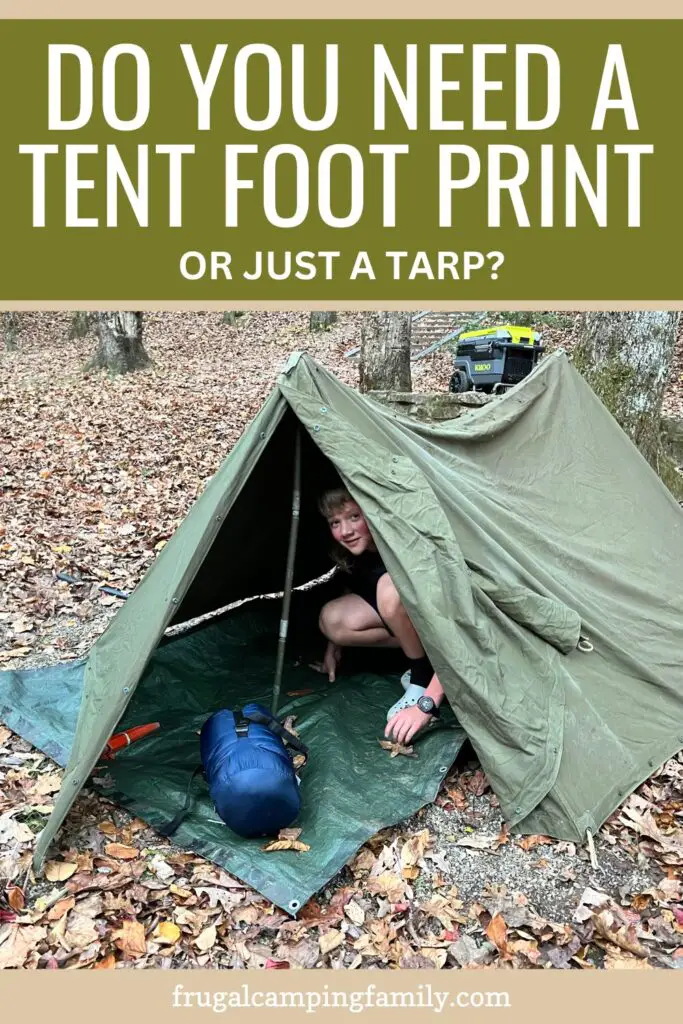Tent camping is enjoyed all over the world by so many people. They pack up and head outdoors to detach and get away, but I bet most of them have never heard of a Tent Foot Print or even given a second thought to protect the bottom of their tent.
The ground below can be rocky, bumpy, or have sharp objects (like little twigs) that could puncture the floor of your tent, giving way to moisture and eventually causing large tears. This is when adding extra protection, like a footprint, can help you out.

What is a Tent Footprint Anyway?
A tent footprint or groundsheet is just a lightweight sheet of barrier fabric or material that is slightly smaller than the size of your tent and lies underneath between the tent floor and the ground below.
Traditional footprints (pre-fabricated) are usually made of the same fabric as your tent but thicker. They help keep friction from tearing the bottom of the tent while you are moving around inside, and they keep moisture from the ground off the tent floor.
The tent floor will often deteriorate much faster when they’re exposed to just the outside elements of camping. So, it doesn’t really matter what your footprint is made of as long as it is waterproof and can provide some protection.
You can use a pre-fabricated one or make your own from different things like plastic, vinyl, Tyvek, or rubber. When we hiked a section of the Appalachian Trail, we saw a hiker using a piece of Tyvek under his air pad (he was sleeping in shelters).
We learned the importance of a footprint on that trip…we ended up with a small home in our tent from not having one.
What Do You Use the Tent Footprint For?
A good tent footprint acts as a protection layer from the cold and often wet ground. Even the best quality tents perform better when you protect them from the elements. Once those rips and tears start, there is usually no going back.
You never know when a small rock or twig is going to wreak havoc on your tent from below.
Footprints also offer extra insulation, help keep the tent clean, and keep mold and mildew off.
Other Uses for a Tent Footprint
You can use them for extra rain protection, tent patching, gear sorting, ground cover to picnic on, or to insulate things like your car’s windshield.

What is a Tarp?
A tarp is the first thing we pack when we get our camping gear together. It’s the most versatile thing we pack, having so many uses.
It’s basically just an affordable, lightweight, and very waterproof blend of plastic and vinyl. Most tarps come in a variety of sizes but you can cut them to fit exactly the way you want them to underneath your tent.
Tarps are very effective at keeping water off your tent as well as other things around the site.
What is a Tarp Used for in Camping?
It is a floor protector and water barrier for the tent. You can also use it for shade. We have hung them up before around the campsite for that very reason.
We have also used tarps to keep us dry when it has rained. It seems that we can never go tent camping in the North Georgia Mountains without a rainstorm. We have draped our tarps over the tent and our stuff as well as hung them to stand under when it rains.
You can hang a string or rope and use a tarp to make an A-Frame shelter for protection against nature’s many different elements.

If you need to resize your tarp but don’t want to cut it, you can always fold it several times until it fits like you want it to.
Do I Need Tent Floor Protection?
You absolutely do!
Update: We recently hiked an 11-mile section of the Appalachian Trail with our 11 year old. We spent the night and took our Kelty hiking tent with us. The problem with this was we didn’t bring a footprint because we thought that one night wouldn’t hurt a thing…wrong! We now have visible wear spots on the floor of our tent.
Make sure if you make your own footprint, you cut it 1 to 2 inches smaller than the tent floor so water doesn’t collect around the outside of the tent during a rainstorm. This is nothing more than a moisture trap that can cause problems!
Tent Footprint vs Tarp: Which to Use?
Well, we now know that we definitely need to protect our tent’s floor. But whichever one you choose is totally up to you. We use tarps because they are the friendliest to the budget and it’s the easiest to get.
If you are going camping where you expect the ground to be rough, you should consider a more durable material like rubber. If you can afford a custom footprint, it will serve you the best but we have had good luck from our tarps.
You can also create a custom footprint out of a painter’s tarp, Since the plastic is very rigid and the tarp is inexpensive, it would work well.
Tyvek (house wrap) is a great DIY option too because you almost can’t destroy that stuff, lol. Plus it’s cheap and waterproof while being more resistant to punctures.
Update: When we were hiking, there was a through hiker on the AT that used tyvek to make a footprint that he laid down under his sleeping pad. It was light weight and its very durable. It was a great idea.

The Bottom Line: Tent Footprint vs Tarp
Do you need a tent footprint? The answer is YES!
If you have any other ideas, leave a comment below, we love hearing other people’s suggestions.
If you need some help getting started with tent camping, see our beginner’s guide here.

